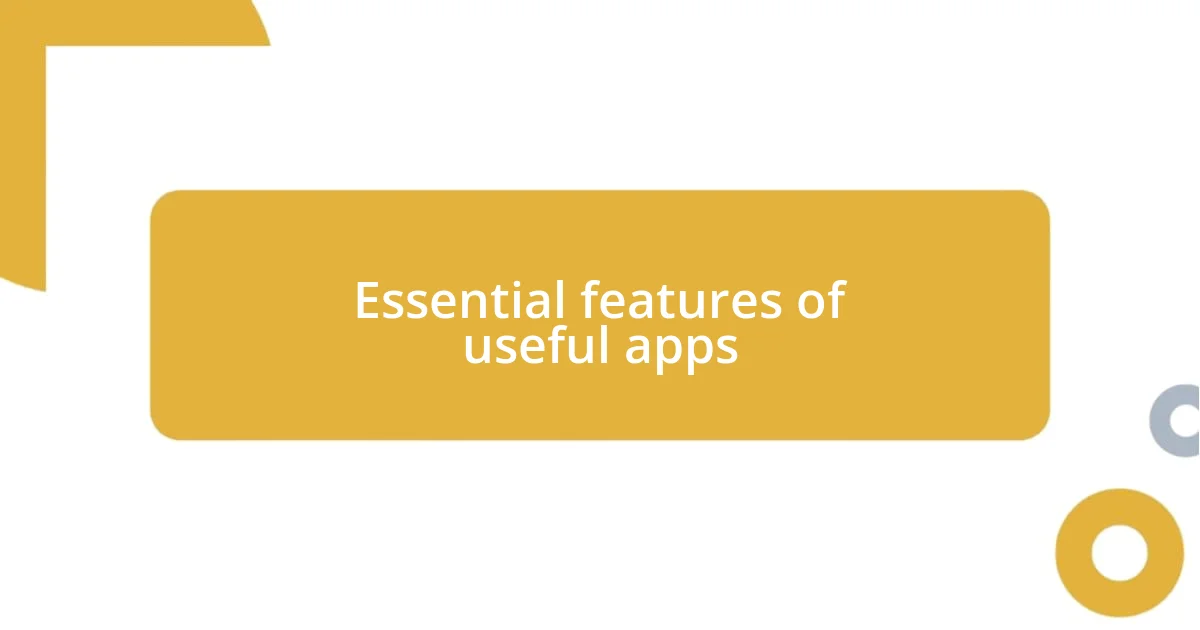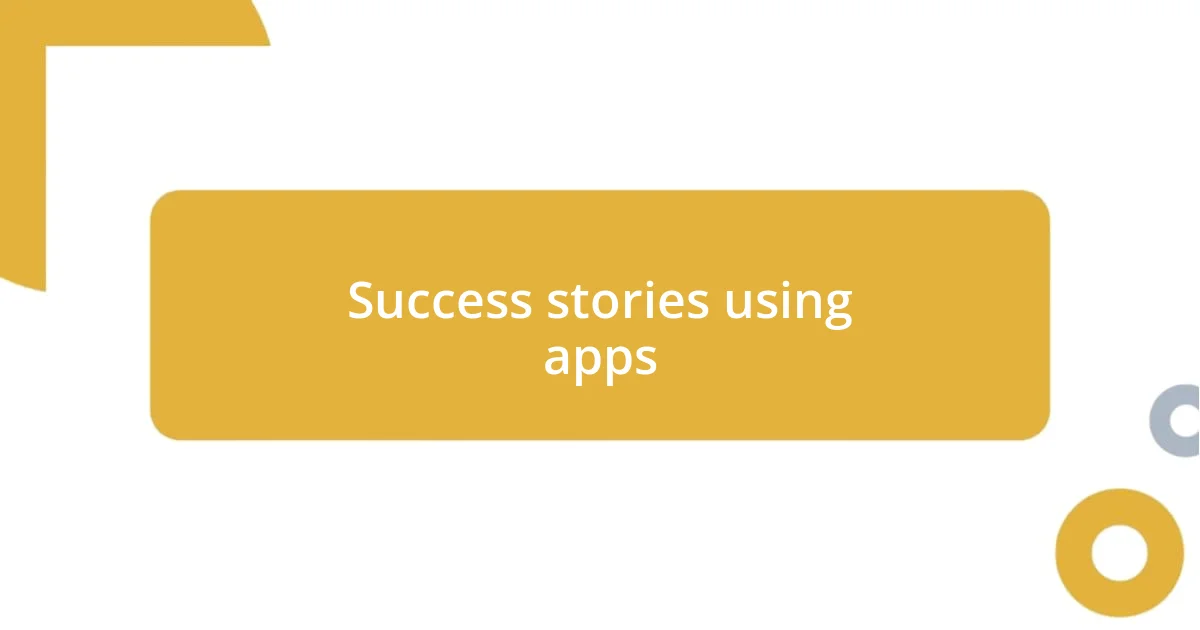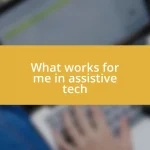Key takeaways:
- Apps for special needs can significantly enhance communication and learning by providing customized features that cater to individual needs.
- Tracking progress through mobile tools fosters motivation and confidence by visually representing achievements and facilitating immediate feedback.
- Success stories illustrate the transformative impact of apps, empowering individuals with special needs to engage socially and gain independence in their daily routines.

Understanding special needs apps usage
Understanding how to effectively use special needs apps is vital. I’ve seen first-hand the difference a well-designed app can make in someone’s daily routine. Have you ever witnessed a child light up during a learning activity? It’s those moments that truly highlight the potential of technology in supporting unique needs.
When I started using these apps, I was overwhelmed by the sheer number of options available. Which ones really make a difference? I remember spending endless hours trying different tools before finding those that really resonated with my needs. The right app can feel like a personalized tutor, adapting to individual learning styles and making difficult tasks feel manageable.
One thing I’ve learned is that each app serves a different purpose; some enhance communication, while others focus on structure or learning new skills. It’s essential to match the app’s functionality with the user’s specific challenges. The joy of progress is palpable, whether it’s mastering a new word or completing a task independently. Isn’t it incredible how a simple app can foster independence and encourage growth?

Essential features of useful apps
When I consider the essential features of useful apps for special needs, I immediately think about customization. It’s so important for these tools to cater to individual needs. I recall a time when I found an app that allowed me to adjust the difficulty level based on progress. It felt empowering to see my progress visually represented; that made all the difference in keeping me motivated.
Here are some key features that I believe every effective app should have:
- User-Friendly Interface: Intuitive design helps users navigate easily without frustration.
- Customizable Settings: Ability to adjust settings to fit personal preferences and learning styles.
- Interactive Elements: Engaging visuals and activities that motivate users to learn and interact.
- Progress Tracking: Insights into achievements can boost confidence and provide a sense of accomplishment.
- Support Resources: Access to guidance, tutorials, or customer support can enhance the user experience.
Moreover, I find that consistency is key. An app that provides regular prompts or reminders can significantly improve routine and structure, which is particularly helpful for those who thrive on predictability. I remember introducing a scheduling app that sent alerts for daily activities; it transformed how I managed my time. Suddenly, I was not just keeping up but confidently owning my schedule. Establishing consistent support through technology opens doors for growth and independence.

Enhancing communication with apps
One of the most profound ways I’ve seen apps enhance communication is through assistive technology. For example, I remember the first time I introduced my friend to a speech-generating app. Watching her express herself with newfound clarity was nothing short of magical. It felt like unwrapping a gift; the joy and relief in her eyes spoke volumes. This kind of technology can bridge the gap for individuals who might struggle with traditional forms of communication, allowing them to engage more fully with others.
In my experience, the best communication apps are those that provide multiple modes of expression. For instance, some apps allow not only text or speech but also visual aids like pictures or symbols. I’ve often found that combining these elements can lead to richer interactions. When my son used a picture-based app for communication, it not only helped him articulate his thoughts but also encouraged his peers to interact with him in more meaningful ways. Suddenly, he was not just part of the conversation; he was leading it!
Moreover, I’ve noticed that some apps incorporate options for social stories, which can be a game-changer. These stories help users understand and navigate social situations effectively. I recall when my daughter started using one of these apps before a big school event. It laid out scenarios and responses that made her feel more confident and prepared. The transition from apprehension to excitement was remarkable, illustrating how the right app can transform communication and social interactions for those with special needs.
| App Feature | Benefit |
|---|---|
| Speech Generation | Facilitates clearer expression |
| Visual Aids | Improves comprehension and engagement |
| Social Stories | Prepares users for social interactions |

Tracking progress with mobile tools
Tracking progress with mobile tools has profoundly changed how I understand and support individual growth. One app I’ve used lets me log daily achievements, and there’s something truly satisfying about seeing those little victories accumulate over time. Could it be that this visual representation not only keeps the user motivated but also ignites that spark of joy in celebrating each step? Absolutely. Every time I fill in a new accomplishment, I feel a rush of confidence, and I can see that the person I’m supporting feels it too.
When it comes to tracking larger milestones, I’ve found that setting specific goals within the app can make all the difference. I remember when I was helping a student prepare for an important skill assessment. By breaking down the learning objectives into achievable, trackable tasks, we created a sense of focus and direction. Every milestone reached wasn’t just a checklist item; it was a moment of pride and assurance. Honestly, have you ever felt that kind of exhilaration when reaching a goal? The app turned our learning journey into an engaging race to the finish line, where every completed task was a well-deserved cheer!
Moreover, feedback features in mobile tools play a crucial role in progress tracking. I’ve seen firsthand how immediate feedback can enhance learning experiences. For instance, my niece used an app that provided real-time responses to her activities. The encouragement she received with each correct answer was like hearing a supportive cheerleader in her pocket! It’s fascinating how the right tool can transform not just the way we track progress but also how we emotionally connect with the learning process. Isn’t it wonderful to think that a simple app can serve as such a powerful ally in recognizing and celebrating individual growth?

Success stories using apps
Using apps for special needs has truly given rise to remarkable success stories. I recall a parent sharing how her son, who had always been hesitant in social situations, began using a social skills app. Within weeks, he was not only initiating conversations but also sharing his interests with others. The smiles he brought to both his face and his peers’ were heartwarming, illustrating how the app enabled genuine connections. Isn’t it amazing to witness such transformations?
I’ve also had the privilege of observing a dedicated group of educators implementing a learning app in their classroom for children with autism. They were initially skeptical, thinking technology might be a distraction instead of a tool. What happened next was astounding: the app’s interactive elements engaged the students in ways traditional methods hadn’t. One child, who rarely participated, began answering questions out loud, surprising everyone. The teachers learned that sometimes, it takes the right medium for a spark of engagement to ignite.
Furthermore, I remember a case where a caregiver integrated a visual scheduling app into the daily routine of their client with developmental delays. The caregiver noted a significant decrease in anxiety during transitions. It was delightful to hear how the client would confidently reference the app, pointing to upcoming activities with a sense of control. Can you imagine the empowerment they felt? It’s these kinds of moments that truly exemplify how apps can support independence and foster a sense of security for individuals with special needs.











